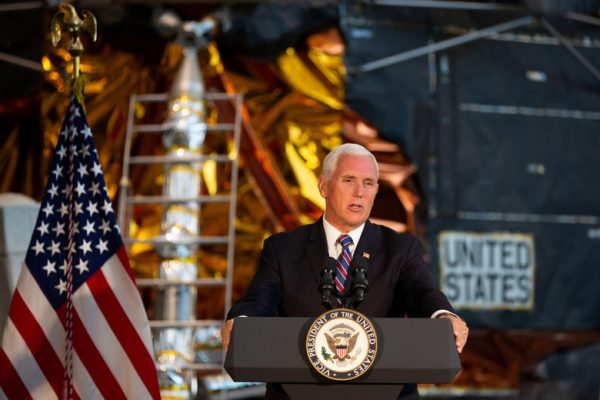Could a Mars Fantasy Ruin NASA’s Space Exploration? – Slate
Mike Pence at the unveiling of Neil Armstrong’s Apollo 11 spacesuit at the Smithsonian National Air and Space Museum on July 16, 2019, for the 50th anniversary of the launch mission.
Alastair Pike/Getty Images
Last spring, Mike Pence called for NASA to return astronauts to the moon, pronto. NASA got to work. The program, eventually named Artemis after the twin sister of Apollo, aims to land the first woman and next man on the moon by 2024. While the timeline has been called fanciful, Artemis has gained momentum in the past year and secured funding and partnerships. For the first time since Apollo 17 in 1972, a lunar landing seemed within reach.
But last Friday, House legislators introduced a bipartisan bill that effectively snubs Artemis. H.R. 5666, an authorization act for NASA, sparked immediate concern in the space policy community. If enacted, H.R. 5666 would move the lunar landing date to 2028 and shift the goal of human spaceflight to Mars.
While it’s still far from becoming law, H.R. 5666 highlights the continued fixation on what some have called a Mars fantasy. It also shows just how hard launching people into space becomes when it’s left in the hands not of scientists, but of changing policymakers and administrations.
Authorization bills aren’t required for NASA to operate year-to-year (the last one was signed into law in 2017), but they do set policy and indicate what Congress will be willing to fund. Artemis’ problem, as Casey Dreier, senior space policy adviser for the Planetary Society, puts it, is that it “exists due to executive fiat alone.” And executive fiat can’t fund it. The White House already requested $1.6 billion to kickstart the program—bringing NASA’s budget to more than $22 billion for fiscal year 2020. Instead, Congress provided $600 million and asked the White House for a five-year budget plan, which will be released on Feb. 10.
While NASA’s Artemis program would aim to send humans to Mars in the late 2030s and 2040s, its current focus is lunar exploration and conducting “meaningful activities” on the moon, including establishing a base and extracting lunar resources. The idea is that sustained presence on the moon will become a bedrock for future exploration.
H.R. 5666 would scrap that notion for the sake of speed. Rep. Kendra Horn, a Democrat from Oklahoma and chairwoman of the space subcommittee, even spoke of the bill in terms reminiscent of the urgency and national unity of the Space Race. She said in a press release, “Americans should be the first to set foot on the Red Planet, and H.R. 5666 moves us closer to that goal by directing a steady and sustainable course of action.”
H.R. 5666’s plans rely on a regular lunar missions starting in 2028, but for the express purpose of a crewed Mars orbit mission by 2033. The bill prohibits the possibility, for instance, of developing ways to mine the moon’s resources. It also calls for NASA’s creation of a “Moon to Mars” program office within 60 days that would be responsible for creating an “integrated, master plan” for human spaceflight to the red planet.
Since its introduction, H.R. 5666 has received widespread criticism, and not just because it reflects politicians determining scientific goals. Although Artemis has been criticized for its rushed timeline, space policy experts and NASA’s Advisory Council have generally supported it for its concrete plans and attempts “to learn from decades of space policy failure,” according to Ars Technica’s Eric Berger. Artemis allows for public-private commercial agreements and encourages competition for fixed-price contracts among companies like SpaceX and Blue Origin, in addition to traditional giants like Boeing. H.R. 5666, as Berger points out, would instead favor a government-owned lunar landing craft and cost-plus contracts exclusively with Boeing. The Commercial Spaceflight Federation denounced the bill for this reason, arguing that it “set[s] NASA up for failure,” and NASA Administrator Jim Bridenstine expressed serious concern that H.R. 5666 “imposes some significant constraints on our approach to lunar exploration.”
And that doesn’t even get to what is perhaps the most concerning aspect of H.R. 5666. As more than a few critics have mentioned: Redirecting exploration to Mars by 2033 is simply unfeasible. The cost, risks, and necessary technological advances, according to a 2019 study by the Science and Technology Policy Institute, are too great. (The estimated expense of just one Mars mission, without the prerequisite lunar missions, is $120.6 billion, and Berger argues that the House would have to at least double its human exploration budget for it to be a possibility.) Additionally, by shortening the timeline for Mars and pushing the moon landing timeline to 2028, H.R. 5666 would make a moon landing less likely, given how much can change between different administrations.
Still, it’s just a bill and likely won’t be passed as-is. The House space subcommittee changed little in its markup of H.R. 5666 on Wednesday, but if it’s eventually passed, H.R. 5666 will have to be reconciled with the Senate’s 2019 version of the NASA authorization bill, which is closer to Artemis, but is still more Mars-focused and doesn’t include a lunar landing timeline.
Space exploration may be one of the few issues that isn’t partisan, but chronically different visions, often driven by passing whims and ambitions, have long made for muddled, unsuccessful space policy. For now, what the House has come up with may not align with Pence’s ambitions (or those of the current Administration as a whole), but we can rest assured that H.R. 5666 corresponds to Trump’s infamous agenda circa June 2019:
Future Tense is a partnership of Slate, New America, and Arizona State University that examines emerging technologies, public policy, and society.






